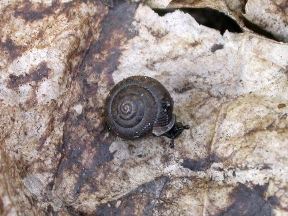Daedalochila polita - Suave Liptooth
Classification
The formal classification of the land snail, Daedalochila polita, is as follows:
Kingdom: Animalia
Phylum: Mollusca
Class: Gastropoda
Order: Stylommatophora
Family: Polygyridae
Genus: Daedalochila
Species: Daedalochila polita

The common name for the Daedalochila polita is suave liptooth. This snail used to be classified as Polygyra polita (Tamaulipas liptooth).
Species Daedalochila polita
The Species polita has a glossy surface with fine, but weak striations (Pilsbry, 1940). These striations are usually fading or evenly developed depending on the environment they are found in, but the striations can usually always be seen better towards the base (Pilsbry, 1940). When viewing the umbilicus one can see the minute papillae around the outside, which vary in color (Pilsbry, 1940). The parietal tooth of polita can very from short to long and the peripheral end points in the direction of the upper lip tooth (Pilsbry, 1940). The upper lip teeth vary from being very strong, to short and weak (Pilsbry, 1940).
Genus Daedalochila
The Daedalochila polita is the reformed name of the snail. The scientific name before they renamed it in 1995 was Polygyra polita. The Genus Polygyra have a few common characteristics. They have a shell that is usually larger than 4.5 mm in diameter, or without a prominently deflected aperture if smaller (Burch, 1962). The Subgenus Polygyra also have an apertural lip without teeth (Burch, 1962). Snails of the genus Daedalochila are classified as having a lip which holds two or three teeth and being 5-10 mm in diameter (Pilsbry, 1940).
Family Polygyridae
The Daedalochila polita is classified to belong to the Family Polygyridae by some specific characteristics. This family is a medium to large type of helicid snail that contains lips and toothed apertures (Burch, 1962). This family can be found in the temperate climates ranging from Alaska, Canada, and even the tropics (Burch, 1962). They are mainly found in woodland areas with regions of high humidity (Burch, 1962). These characteristics are all true of Daedalochila polita.
Order Stylommatophora
Daedalochila polita fits the Order Stylommatophora because they are terrestrial pulmonates. They have eyes on top of their tentacles and they breathe oxygen (Hickman et al. 2009).
Class Gastropoda
Daedalochila polita fits the Class Gastropoda because it has torsion (a coiled shell), a concentrated visceral mass, and a radula (Hickman et al. 2009).
Phylum Mollusca
Daedalochila polita fits the Phylum Mollusca by having a coelom, an open circulatory system, and being highly cephalized (Hickman et al. 2009). These characteristics are joined by the head, foot, a mantle covered by a shell, radula, developed eyes, and a soft non-segmented body (Hickman et al. 2009).
Kingdom Animalia
Daedalochila polita fits an organism in the Animalia Kingdom by being multicellular, eukaryotic, heterotrophic and the absence of a cell wall (Hickman et al. 2009). They also are able to respond to stimuli from their surrounding environment and are capable of motion (Hickman et al. 2009).
Domain Eukarya
Daedalochila polita is classified in the Domain Eukarya because it has DNA enclosed in a nucleus (Hickman et al. 2009).
Although understudied, The habitat and adaptations of the Daedalochila fit along well with the over all with the rest of the Family and Genus types.